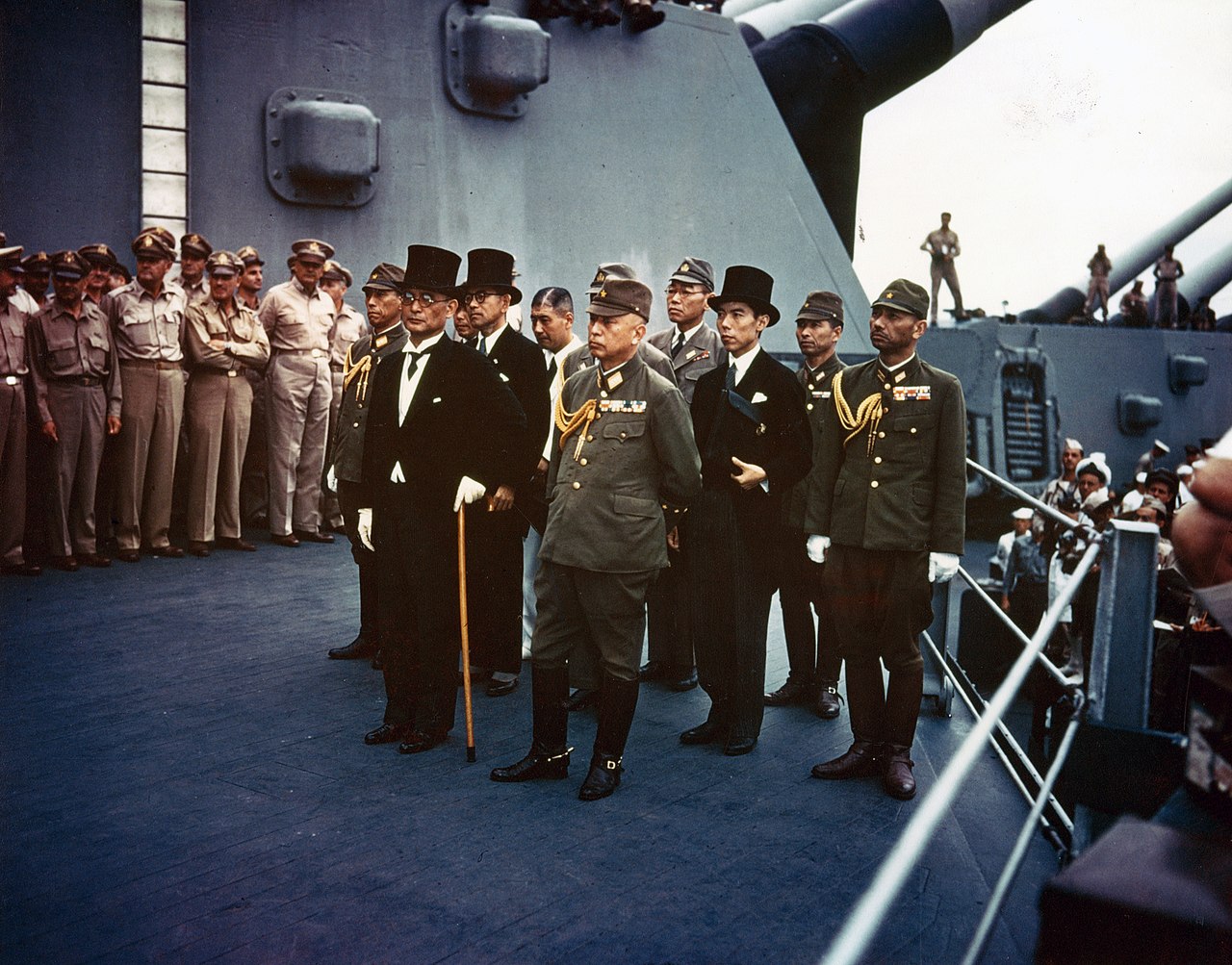World War II ended 75 years ago today when Imperial Japan officially signified its surrender to the United States and its allies on Sept. 2, 1945, aboard the USS Missouri in Tokyo Bay.
The official act of surrender came more than two weeks after Japanese Emperor Hirohito declared over a radio broadcast on Aug. 14, 1945, that Japan’s forces would cease hostilities with the U.S. and its allies and capitulate. On Sept. 2, Japanese Foreign Minister Mamoru Shigemitsu and a delegation of Japanese military and foreign ministry officials arrived aboard the battleship Missouri to sign what is known as The Japanese Instrument of Surrender.

The Japanese delegation aboard the USS Missouri, Sept. 2, 1945. (U.S. Army photo, U.S. National Archives/Released)
U.S. Army Gen. Douglas MacArthur, then designated as the Supreme Commander for Allied Forces in Japan, led the U.S. and allied delegation that accepted Japan’s surrender. MacArthur signed his acceptance of the surrender, as did U.S. Navy Adm. Chester W. Nimitz, and representatives of Great Britain, the Union of Soviet Socialist Republics, China, Canada, France, The Netherlands, Australia and New Zealand.
The official text of the surrender document reads:
We, acting by command of and in behalf of the Emperor of Japan, the Japanese Government and the Japanese Imperial General Headquarters, hereby accept the provisions set forth in the declaration issued by the heads of the Governments of the United States, China, and Great Britain on 26 July 1945 at Potsdam, and subsequently adhered to by the Union of Soviet Socialist Republics, which four powers are hereafter referred to as the Allied Powers.
We hereby proclaim the unconditional surrender to the Allied Powers of the Japanese Imperial General Headquarters and of all Japanese armed forces and all armed forces under the Japanese control wherever situated.
We hereby command all Japanese forces wherever situated and the Japanese people to cease hostilites forthwith, to preserve and save from damage all ships, aircraft, and military and civil property and to comply with all requirements which my be imposed by the Supreme Commander for the Allied Powers or by agencies of the Japanese Government at his direction.
We hereby command the Japanese Imperial Headquarters to issue at once orders to the Commanders of all Japanese forces and all forces under Japanese control wherever situated to surrender unconditionally themselves and all forces under their control.
We hereby command all civil, military and naval officials to obey and enforce all proclamations, and orders and directives deemed by the Supreme Commander for the Allied Powers to be proper to effectuate this surrender and issued by him or under his authority and we direct all such officials to remain at their posts and to continue to perform their non-combatant duties unless specifically relieved by him or under his authority.
We hereby undertake for the Emperor, the Japanese Government and their successors to carry out the provisions of the Potsdam Declaration in good faith, and to issue whatever orders and take whatever actions may be required by the Supreme Commander for the Allied Poers or by any other designated representative of the Allied Powers for the purpose of giving effect to that Declaration.
We hereby command the Japanese Imperial Government and the Japanese Imperial General Headquarters at once to liberate all allied prisoners of war and civilian internees now under Japanese control and to provide for their protection, care, maintenance and immediate transportation to places as directed.
The authority of the Emperor and the Japanese Government to rule the state shall be subject to the Supreme Commander for the Allied Powers who will take such steps as he deems proper to effectuate these terms of surrender.
Signed at TOKYO BAY, JAPAN at 0904 I on the SECOND day of SEPTEMBER, 1945
MAMORU SHIGMITSU
By Command and in behalf of the Emperor
of Japan and the Japanese GovernmentYOSHIJIRO UMEZU
By Command and in behalf of the Japanese
Imperial General HeadquartersAccepted at TOKYO BAY, JAPAN at 0903 I on the SECOND day of SEPTEMBER, 1945, for the United States, Republic of China, United Kingdom and the Union of Soviet Socialist Republics, and in the interests of the other United Nations at war with Japan.
DOUGLAS MAC ARTHUR
Supreme Commander for the Allied PowersC.W. NIMITZ
United States RepresentativeHSU YUNG-CH’ANG
Republic of China RepresentativeBRUCE FRASER
United Kingdom RepresentativeKUZMA DEREVYANKO
Union of Soviet Socialist
Republics RepresentativeTHOMAS BLAMEY
Commonwealth of Australia
RepresentativeL. MOORE COSGRAVE
Dominion of Canada RepresentativeJACQUES LE CLERC
Provisional Government of the French
Republic RepresentativeC.E.L. HELFRICH
Kingdom of the Netherlands
RepresentativeLEONARD M. ISITT
Dominion of New Zealand Representative

Gen. Douglas MacArthur signs his acceptance of Japan’s surrender on Sept. 2, 1945. (U.S. Navy photo/Released)
Following Japan’s surrender, Gen. MacArthur led the U.S. occupation of Japan, which ended on April 28, 1952, following the signing of the San Francisco Peace Treaty on Sept. 8, 1951.



